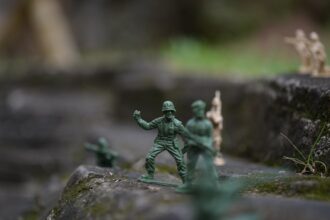The Central Intelligence Agency (CIA) has long been associated with espionage, covert operations, and national security. However, a lesser-known aspect of its activities involves the agency’s engagement with the arts and culture. This cultural front emerged during the Cold War, a period marked by intense ideological rivalry between the United States and the Soviet Union.
The CIA recognized that culture could serve as a powerful tool for propaganda, shaping public perception and influencing global opinion. By investing in various artistic endeavors, the agency sought to promote American values and counteract the spread of communism. The CIA’s cultural initiatives were not merely about promoting art for art’s sake; they were strategic moves designed to bolster the United States’ ideological stance.
Through funding and support for artists, writers, and cultural institutions, the agency aimed to create a narrative that showcased the superiority of American democracy and capitalism. This approach allowed the CIA to operate in a realm that was less scrutinized than traditional intelligence activities, enabling it to wield influence in ways that were often subtle yet impactful. As such, the CIA’s cultural fronts became an integral part of its broader strategy during a tumultuous period in world history.
Key Takeaways
- The CIA has been involved in funding and influencing cultural organizations and institutions as part of its covert operations.
- The CIA has used artists and writers as assets to promote its agenda and influence global politics.
- The impact of CIA cultural fronts on global politics has been significant, shaping public opinion and promoting American interests.
- The CIA’s involvement in literature, publishing, film, and television has raised criticisms and controversies surrounding its influence on the arts.
- The legacy of CIA cultural fronts continues to influence the arts and global politics, raising questions about the ethical implications of covert operations in the cultural sphere.
The Role of the CIA in the Arts
The CIA’s involvement in the arts was multifaceted, encompassing a wide range of creative expressions, including literature, visual arts, music, and theater. The agency understood that art could transcend language barriers and resonate with diverse audiences, making it an effective medium for conveying ideological messages. By supporting artists who aligned with its objectives, the CIA sought to cultivate a cultural landscape that reflected American ideals while simultaneously undermining opposing narratives.
One of the most notable initiatives was the establishment of organizations such as the Congress for Cultural Freedom (CCF) in 1950. This organization served as a platform for promoting modernist art and literature, positioning them as embodiments of freedom and creativity in contrast to Soviet repression. The CCF organized exhibitions, published magazines, and sponsored events that showcased American artists and intellectuals.
Through these efforts, the CIA aimed to create a cultural counterweight to Soviet propaganda, reinforcing the notion that artistic expression flourished in democratic societies.
Covert Operations and Propaganda in the Arts
The CIA’s cultural operations often blurred the lines between art and propaganda. While many artists were genuinely committed to their craft, some were unwittingly used as instruments of state-sponsored messaging. The agency employed covert tactics to ensure that its influence permeated various artistic domains without revealing its hand.
This included funding exhibitions and publications that aligned with its ideological goals while maintaining plausible deniability regarding its involvement. One of the most striking examples of this covert approach was the CIA’s support for abstract expressionism during the 1950s and 1960s. Artists like Jackson Pollock and Mark Rothko became symbols of American artistic innovation, and their works were promoted as representations of freedom and individualism.
The CIA recognized that abstract expressionism could be positioned as a stark contrast to Soviet realism, which emphasized socialist themes. By championing these artists on the international stage, the agency sought to project an image of America as a bastion of creativity and freedom.
The CIA’s Influence on Literature and Publishing
| Year | Event | Impact |
|---|---|---|
| 1947 | CIA establishes Congress for Cultural Freedom | Supports anti-communist intellectuals and funds literary magazines |
| 1950s-1960s | CIA funds literary journals and cultural organizations | Shapes cultural and literary discourse in Cold War era |
| 1967 | Ramparts magazine exposes CIA’s funding of literary organizations | Reveals covert influence on literature and publishing |
| 1970s | CIA’s influence on literature and publishing declines | Public scrutiny leads to decreased covert funding |
Literature was another critical area where the CIA exerted its influence. The agency recognized that written works could shape public opinion and foster ideological alignment. To this end, it funded literary magazines and publishing houses that promoted anti-communist narratives while showcasing American authors.
This effort was particularly evident in Europe, where the CIA sought to counteract the appeal of socialist literature. One notable example was the support for the Paris-based magazine “Les Temps Modernes,” founded by Jean-Paul Sartre. While Sartre himself was a leftist intellectual, the CIA’s funding allowed for a diverse range of voices to be published, including those critical of communism.
This strategic investment in literature not only provided financial backing but also facilitated the dissemination of ideas that aligned with American values. By promoting works that celebrated individualism and freedom, the CIA aimed to create a literary landscape that resonated with audiences both domestically and abroad.
The CIA’s Involvement in Film and Television
The film industry also became a focal point for CIA cultural initiatives. Recognizing the power of cinema as a medium for storytelling and persuasion, the agency sought to influence Hollywood productions to reflect its ideological goals. This involvement ranged from direct funding of films to more subtle forms of influence through partnerships with filmmakers who shared similar values.
Movies like “The Manchurian Candidate” and “Dr. Strangelove” not only entertained audiences but also served as vehicles for political commentary.
The agency understood that film could shape public perceptions of global events, making it an essential tool in its cultural arsenal. By promoting narratives that aligned with its objectives, the CIA aimed to reinforce its stance on issues ranging from foreign policy to domestic governance.
CIA Funding of Cultural Organizations and Institutions
The CIA’s financial backing extended beyond individual artists and projects; it also encompassed entire cultural organizations and institutions. By providing funding to museums, galleries, and cultural festivals, the agency sought to create environments conducive to American artistic expression while simultaneously undermining competing ideologies. This strategic investment allowed the CIA to cultivate relationships with influential figures in the arts community, further extending its reach.
Organizations like the CCF played a pivotal role in this endeavor by organizing events that showcased American culture on an international scale. Through exhibitions featuring American artists and performances highlighting American music, these organizations helped shape perceptions of U.S. culture abroad.
The CIA’s funding enabled these initiatives to flourish, creating a network of cultural ambassadors who promoted American values through their work.
Artists and Writers Used as CIA Assets
While many artists and writers were unaware of their connection to the CIA, some willingly collaborated with the agency in pursuit of shared goals. These individuals often viewed their involvement as a means of promoting freedom and democracy against oppressive regimes. The agency capitalized on their talents and reputations to further its agenda, blurring the lines between artistic integrity and political allegiance.
Notable figures such as poet Allen Ginsberg and novelist Norman Mailer were among those who engaged with CIA-sponsored initiatives at various points in their careers. While their motivations may have differed—ranging from genuine belief in democratic ideals to opportunistic pursuits—their contributions inadvertently served the agency’s objectives. This complex relationship between artists and intelligence agencies raises questions about authenticity in art and the ethical implications of using creative expression as a tool for political ends.
The Impact of CIA Cultural Fronts on Global Politics
The impact of the CIA’s cultural fronts extended far beyond individual artists or specific projects; it played a significant role in shaping global politics during the Cold War era. By promoting American culture as a counter-narrative to Soviet ideology, the agency sought to win hearts and minds around the world. This cultural diplomacy aimed not only to bolster U.S.
influence but also to undermine communist movements by presenting an alternative vision rooted in freedom and creativity. In regions where communism held sway, such as Eastern Europe or Latin America, CIA-sponsored cultural initiatives often provided a lifeline for dissident voices seeking to challenge oppressive regimes. By amplifying these voices through art and literature, the agency contributed to broader movements advocating for democratic reforms.
The interplay between culture and politics became increasingly evident as artists emerged as key figures in resistance movements against authoritarianism.
Criticisms and Controversies Surrounding CIA Cultural Fronts
Despite its strategic successes, the CIA’s involvement in cultural fronts has not been without controversy.
The notion that artists could be co-opted into serving state interests raises ethical questions about authenticity and autonomy within creative expression.
Moreover, revelations about CIA funding have led some artists to grapple with their complicity in state-sponsored narratives. For instance, discussions surrounding abstract expressionism often highlight how artists like Pollock became unwitting pawns in a larger geopolitical game. This tension between artistic freedom and political allegiance continues to resonate within contemporary discussions about art’s role in society.
The Legacy of CIA Cultural Fronts
The legacy of the CIA’s cultural fronts is complex and multifaceted. On one hand, these initiatives contributed significantly to shaping perceptions of American culture both domestically and internationally during a critical period in history. They fostered artistic innovation while providing platforms for voices advocating for democracy and freedom.
On the other hand, this legacy is marred by ethical dilemmas surrounding state-sponsored art and propaganda. The blurred lines between genuine artistic expression and political manipulation raise important questions about accountability within creative communities. As contemporary artists navigate these complexities, they continue to grapple with their roles within broader socio-political contexts.
The Continued Influence of the CIA in the Arts
In conclusion, while the Cold War may have ended decades ago, the influence of the CIA in the arts remains relevant today. The agency’s cultural fronts serve as a reminder of how art can be wielded as both a weapon and a shield in ideological battles. As new forms of media emerge and global dynamics shift, understanding this historical context becomes increasingly important for artists navigating contemporary challenges.
The interplay between culture and politics continues to evolve, with new actors entering the stage while old narratives persist. As artists grapple with their roles within society—whether as advocates for change or participants in state-sponsored initiatives—the legacy of CIA cultural fronts serves as both cautionary tale and source of inspiration for future generations seeking to navigate these complex waters.
In exploring the intricate ways the CIA utilized cultural fronts during the Cold War, it’s fascinating to consider the broader implications of intelligence agencies influencing cultural and artistic movements. A related article that delves into similar themes can be found on “In The War Room,” which provides insightful analysis on the intersection of culture and intelligence operations. For a deeper understanding of these dynamics, you can read more about it on their sample page. This article complements the discussion by shedding light on how cultural influence has been a strategic tool in geopolitical maneuvers.
CHECK THIS OUT! 📽️🎞️ Hollywood’s Secret War: How the CIA Rewrote Movies
FAQs
What are cultural fronts?
Cultural fronts are organizations or institutions that are used to promote a particular culture, ideology, or political agenda. They can include art galleries, literary magazines, music festivals, and other cultural institutions.
How did the CIA use cultural fronts?
The CIA used cultural fronts as part of its efforts to promote American values and counter the influence of communism during the Cold War. This included funding and supporting various cultural organizations and events that aligned with the agency’s goals.
What were the motivations behind the CIA’s use of cultural fronts?
The CIA’s use of cultural fronts was motivated by a desire to shape global perceptions of the United States and its values, as well as to counter the influence of communist ideology. By supporting cultural organizations and events, the CIA aimed to promote American ideals and counter the spread of communism.
What impact did the CIA’s use of cultural fronts have?
The CIA’s use of cultural fronts had a significant impact on the global cultural landscape during the Cold War. It helped to shape perceptions of the United States and its values, and also influenced the cultural and artistic movements of the time. However, it also sparked controversy and criticism, particularly regarding the agency’s covert involvement in cultural activities.




